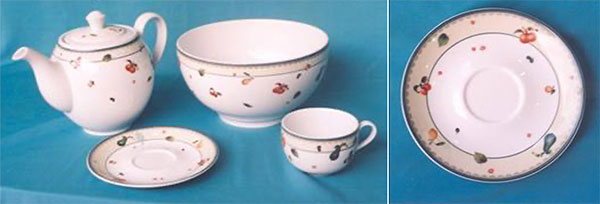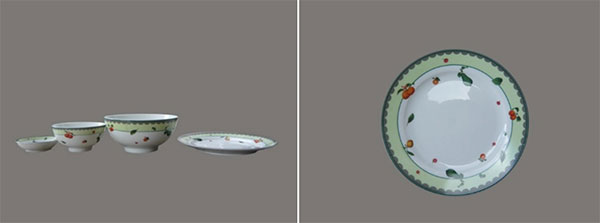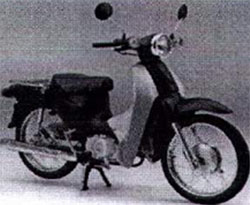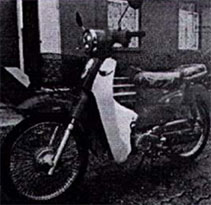How to assess design infringement in Vietnam
17 January 2020
By LE Hoai Duong1, B.Sc., LL.B, MIP (Franklin Pierce)
In the early 1990s, under the customer test, as formulated and reiterated by the Industrial Design Division1 at the Intellectual Property Office of Vietnam (the IP Vietnam), infringement was found when the accused design was found to differ from the registered design in minor respects, as determined by the customer (generally, a person who was familiar with the product, or similar products, to which the design relates).
This test looking to the customer’s overall impression was in effect until the end of 2009 when the IP Vietnam significantly modified it in Minh Long v. Lan-Hiếu (2009).

The Design Patent No.7638 in the name of Minh Long Company Ltd.

The claimed ornamental feature of the 7638 patented design
The accused design of the shop Lan-Hiếu
The shape and form of the products (dishes and bowls) in which the 7638 design was incorporated were common and dictated by functional considerations. These functional features therefore were neither listed in the 7638 design application nor shown in details in its pictures, while the new and distinctive ornamental features were clearly claimed and depicted. The shape and form of the accused design, which were also common, were almost identical to those of the 7638 design. And, the ornamentations of the two designs in question were substantially the same.
LÊ & LÊ, representing the patented design owner, argued that the consumer, who was familiar with the basic features of the products, when assessing the overall impression of the designs, knew that the very ornamentation could produce a different overall impression, despite of sharing the common features (i.e., the shape and form of the products). Therefore, from the standpoint of the consumer, the use of the same or substantially the same ornamentation on the same products constituted an infringement of the patented design 7638.
However, the IP Vietnam, asked by the Ministry of Science and Technology’s Inspectorate (which is one of the administrative enforcement agencies) for its opinion, held that when avaluating the overall appearance of the two designs, the ornamental and shape features should be considered “inextricably intertwined and inseparable”, and that the two designs in question were significantly different, and therefore, there was no infringement.
This assessment of the IP Vietnam was unrealistic, not through the eyes of the consumer, and made an inherently murky area of design law much unclearer.
After the IP Vietnam’s controversial opinion in Minh Long v. Lan-Hiếu, the test for design infringement, as provided for in Article 126.1 of the LIP and Article 10 of Decree 105, remains unchanged and is still not guided; while the test for design novelty gradually2 changed into, and eventually copied, the Soviet Union’s principle at the beginning of the 1980s.
As opposed to the design infringement test, the design novelty test relies on an analysis of how well the applicant’s design can be distinguished from prior art when comparing the “combination of essential features” of the applicant’s design with that of a single prior art design. And, novelty is established if the former “has at least one essential feature” found outside the latter.
In practice, design infringements are often determined arbitrarily. Specifically, in many cases, the Soviet Union’s type of the design novelty test is used wrongly for assessing design infringement.
In the most recent case, Honda v. Đồng Minh, in November 2019, Vietnam Intellectual Property Research Institute (VIPRI)3 did wrongly apply the design novelty test to assessing infringement.
 The patented design of Honda (Patent No.14250) |
 The accused design of Dong Minh |
Following the Soviet Union’s type of the design novelty standard, highly subjectively, the VIPRI divided the motorbikes in which the designs in question are incorporated into 06 main parts/essential features - “front part (including headlight, speedometer, handlebars, mirror); splashguards; front mudguard and tire; seat; frame, back tire and gear box; back part (i.e., tail light and sidelights) - and then compared these essential features feature by feature.
The test the VIPRI performed did not look to the consumer’s overall impression; conversely, the VIPRI’s infringement analysis with five(!) pages describing the design features seemed like an attempt at defining these designs in terms of patent claims, when in fact they were simply the appearances of the products.
Remarkably, without considering the designs in light of the prior art and their functional elements, the VIPRI argued that the six essential features of the two designs were similar and the accused design contained no additional essential feature; then the VIPRI concluded that the two designs were “insignificantly different”, implying in their context that infringement was found.
Ironically, under this VIPRI test, the accused design, even though copying all the six essential features of the patented design, does not infringe the patented design if the former incorporates only one additional essential feature!
If infringers could get away from liability by simply adding only one additional essential feature into the accused design, design protection in Vietnam would become useless.
Notes
1 1986-1993: LE Hoai Duong, the founding member of LÊ & LÊ, is former design examiner, Head of Industrial Design Division, and Deputy Director of Industrial Designs & Trademarks Department of the Intellectual Property Office of Vietnam (IP Vietnam).
2 Circular 01 as promulgated in 2007 and then amended in 2010, 2011, 2013 and 2016.
3 VIPRI is a governmental institute of Ministry of Science and Technology of Vietnam. One of the VIPRI’s functions is to provide legal opinions in IP disputes. http://vipri.gov.vn/gioi-thieu/chuc-nang.
The VIPRI’s opinions in intellectual property disputes, like the IP Vietnam’s ones, though not binding, are often influential in courts and other IPR enforcing authorities (i.e., the economic police, the market surveillance agency, and the inspectorates) in Vietnam.
Copyright © LÊ & LÊ, LLC.


